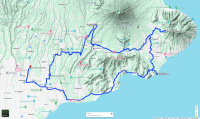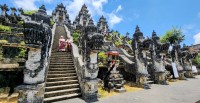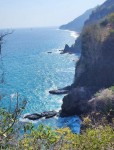Intro
After a busy few weeks of holidays, work, and birthdays, we are back on the job of writing and we hope to finish postings of our October trip in the next few weeks. I hope you enjoy them.
Remember, to see larger versions of the photos along with their descriptive captions, click on the gallery photos at the bottom of the webpage. You can conveniently use the arrow keys to go forward and back through them. To enjoy a nice soundscape while you read and view photos, you can listen to the Balinese instrumental music playlist Neil created a on Spotify. We listen to it while writing to help us get in the proper mindset. Accounts on Spotify are free and you’ll need one to listen at this link: Bali Soundtrack.
Monday, October 16, Day 3 East Bali
Our driver, Wayan, picked us up at 7:00 a.m. We’d been up about an hour by then, having our morning matcha green tea as usual, along with a to-go breakfast of a couple hard boiled eggs and some fruit. The hotel made it up for us and delivered it the night before and we kept in our mini fridge, very convenient.
 Even though distances were short, traffic is terrible on Bali and our driver estimated a 10-hour day for us to make a circuit of a few important stops in southeast Bali. First on our list was Pura Besakih, also called the Mother Temple since it has been the most important Hindu temple on Bali since at least the 1400s, and it was an ancient holy place before that. Neil had visited it in 1995 and had a beautiful experience. Back then he drove up on a motorbike, parked by a side gate and wandered right on in with nobody else visible.
Even though distances were short, traffic is terrible on Bali and our driver estimated a 10-hour day for us to make a circuit of a few important stops in southeast Bali. First on our list was Pura Besakih, also called the Mother Temple since it has been the most important Hindu temple on Bali since at least the 1400s, and it was an ancient holy place before that. Neil had visited it in 1995 and had a beautiful experience. Back then he drove up on a motorbike, parked by a side gate and wandered right on in with nobody else visible.
 But first we had a pleasant surprise. Wayan knew Neil wanted to see waterfalls. Our original wish list for the day’s itinerary had included some waterfalls, but they were up side roads and we had eliminated them to bring our planned route down to only 10 hours. However, Wayan knew of one waterfall we could swing past on our way. Air Terjun Tibumana had a lovely swimming hole and would be great for afternoon heat. Since we were there in the early morning before 8 it was almost empty. We enjoyed visiting the beautiful spot but didn’t take time to swim.
But first we had a pleasant surprise. Wayan knew Neil wanted to see waterfalls. Our original wish list for the day’s itinerary had included some waterfalls, but they were up side roads and we had eliminated them to bring our planned route down to only 10 hours. However, Wayan knew of one waterfall we could swing past on our way. Air Terjun Tibumana had a lovely swimming hole and would be great for afternoon heat. Since we were there in the early morning before 8 it was almost empty. We enjoyed visiting the beautiful spot but didn’t take time to swim.
 A short way down the road we briefly stopped to see a rice paddy being planted. It was one of those beautiful moments of serendipity to be in the right place at the right time. It looked like an extended family that was accustomed to coming together to help plant each other’s crops. Keep this rice paddy in mind because we ended up driving past it days later and got a few pictures of the happy little seedlings.
A short way down the road we briefly stopped to see a rice paddy being planted. It was one of those beautiful moments of serendipity to be in the right place at the right time. It looked like an extended family that was accustomed to coming together to help plant each other’s crops. Keep this rice paddy in mind because we ended up driving past it days later and got a few pictures of the happy little seedlings.
 About an hour later we finally arrived at Pura Besakih. We were both blown away at the modern high-capacity infrastructure which had built up to handle the high volumes of tourists and worshipers. A huge multi-level parking structure for at least 1000 cars, plus special areas for dozens of large 50-passenger buses. Luckily for us, it was a very quiet day and the vast spaces seemed almost empty.
About an hour later we finally arrived at Pura Besakih. We were both blown away at the modern high-capacity infrastructure which had built up to handle the high volumes of tourists and worshipers. A huge multi-level parking structure for at least 1000 cars, plus special areas for dozens of large 50-passenger buses. Luckily for us, it was a very quiet day and the vast spaces seemed almost empty.
 We paid our fees and were assigned an English speaking guide. We then rode a shuttle about a kilometer up the hill to the temple gate area. Our guide explained how every family lineage on Bali (26 of them) had a small family temple adjacent to the public temple. He took us inside his family temple and showed us the various shrines and structures, some of which go back 14 generations or more. He then handed us off to a cousin who showed us the public temples.
We paid our fees and were assigned an English speaking guide. We then rode a shuttle about a kilometer up the hill to the temple gate area. Our guide explained how every family lineage on Bali (26 of them) had a small family temple adjacent to the public temple. He took us inside his family temple and showed us the various shrines and structures, some of which go back 14 generations or more. He then handed us off to a cousin who showed us the public temples.
 We carried with us some Canang Sari, small trays of offerings for the temple, which we purchased from some pushy women at the shuttle stop. We planned to pay our respects to the island and people of Bali by doing a traditional offering ceremony. A
We carried with us some Canang Sari, small trays of offerings for the temple, which we purchased from some pushy women at the shuttle stop. We planned to pay our respects to the island and people of Bali by doing a traditional offering ceremony. A s part of the preparation, Neil bought a ceremonial udeng, the traditional headwear for Balinese men. We got it from a little family run stall where we had fun interacting with the newest member of the family who helped Neil pick it out. Sadly, the little guy was not happy going out in the bright sunlight for a photo.
s part of the preparation, Neil bought a ceremonial udeng, the traditional headwear for Balinese men. We got it from a little family run stall where we had fun interacting with the newest member of the family who helped Neil pick it out. Sadly, the little guy was not happy going out in the bright sunlight for a photo.
 The main temple complex is large with wide vistas looking out over the island. With 86 public temples in addition to the 26 family temples, it seems like there are side temples and beautiful carvings everywhere. Evidence suggests the earliest temples may have been 2000 years ago. The meru towers were beautifully eye-catching. We made our way along, trying to look at everything. We could feel it was a sacred holy place with the serenity of hundreds of years of prayer infused into the stone.
The main temple complex is large with wide vistas looking out over the island. With 86 public temples in addition to the 26 family temples, it seems like there are side temples and beautiful carvings everywhere. Evidence suggests the earliest temples may have been 2000 years ago. The meru towers were beautifully eye-catching. We made our way along, trying to look at everything. We could feel it was a sacred holy place with the serenity of hundreds of years of prayer infused into the stone.  There was a funeral limiting access to an area they used, but at a side shrine our guide led us through the process of giving offerings in thanks and gratitude to the beautiful land and people of Bali.
There was a funeral limiting access to an area they used, but at a side shrine our guide led us through the process of giving offerings in thanks and gratitude to the beautiful land and people of Bali.
 Incense lit and offerings complete at Pura Besakih, we proceeded another 350 meters uphill to Pura Gelap, or the Temple of Lightning, which is much less visited. It felt like a much more holy, peaceful place. I found out later it is often used by those who wish for the holy light of the universe to guide them for the benefit of humanity. I still feel slightly transformed by the experience.
Incense lit and offerings complete at Pura Besakih, we proceeded another 350 meters uphill to Pura Gelap, or the Temple of Lightning, which is much less visited. It felt like a much more holy, peaceful place. I found out later it is often used by those who wish for the holy light of the universe to guide them for the benefit of humanity. I still feel slightly transformed by the experience.
 Our next stop, about an hour away, was Pura Lempuyang, often called the Gate of Heaven. It is a breathtaking place, both because of the beauty and because of all the steps to climb. On a clear day you can see Mount Agung in the distance (nice photo at the link above), but Agung was mostly hidden by clouds the day we were there.
Our next stop, about an hour away, was Pura Lempuyang, often called the Gate of Heaven. It is a breathtaking place, both because of the beauty and because of all the steps to climb. On a clear day you can see Mount Agung in the distance (nice photo at the link above), but Agung was mostly hidden by clouds the day we were there. The courtyard and temple were busy with tourists so we didn’t experience it as a sanctuary of the universe as it was originally intended.
The courtyard and temple were busy with tourists so we didn’t experience it as a sanctuary of the universe as it was originally intended.
 From this perspective, the hot springs resort where we stayed at the end of our trip was located on the far side of Mount Agung, and later you’ll see pictures from that direction. Neil vaguely remembers news of the 1963 eruption which killed about 1900 people. More recently it was active 2017-19 spewing lava and ash and causing the airport to close. Nevertheless, Neil said there’s no lava in the forecast and we could hike to the top of Mount Agung as a day trip (please, please).
From this perspective, the hot springs resort where we stayed at the end of our trip was located on the far side of Mount Agung, and later you’ll see pictures from that direction. Neil vaguely remembers news of the 1963 eruption which killed about 1900 people. More recently it was active 2017-19 spewing lava and ash and causing the airport to close. Nevertheless, Neil said there’s no lava in the forecast and we could hike to the top of Mount Agung as a day trip (please, please).
 Not far away from Pura Lempuyang, and on our way back, we stopped at Taman Tirta Gangga, a beautiful spring-fed water park. While the spring itself has been considered holy for hundreds of years, the water gardens are privately owned by the descendants of the Raja of Karangasem, who began construction in 1946. We hadn’t planned on swimming, but the pools sure looked inviting. T
Not far away from Pura Lempuyang, and on our way back, we stopped at Taman Tirta Gangga, a beautiful spring-fed water park. While the spring itself has been considered holy for hundreds of years, the water gardens are privately owned by the descendants of the Raja of Karangasem, who began construction in 1946. We hadn’t planned on swimming, but the pools sure looked inviting. T here was an area where some minor construction was underway and we were intrigued to see them move a large mound of soil not with wheelbarrows or motorized scoop loaders, but with a line of about a dozen women who balanced large baskets of soil on their heads. In two trips they moved a truck load of soil (almost 80 cubic feet)!
here was an area where some minor construction was underway and we were intrigued to see them move a large mound of soil not with wheelbarrows or motorized scoop loaders, but with a line of about a dozen women who balanced large baskets of soil on their heads. In two trips they moved a truck load of soil (almost 80 cubic feet)!
 Since we were close to the east side of the island, Neil asked to get pictures of a beach. Wayan knew a great spot and drove us to a white sand beach called Virgin Beach. It looked so inviting we both got out our suits. I just enjoyed the cool breeze and took pictures.
Since we were close to the east side of the island, Neil asked to get pictures of a beach. Wayan knew a great spot and drove us to a white sand beach called Virgin Beach. It looked so inviting we both got out our suits. I just enjoyed the cool breeze and took pictures.  Neil swam out beyond the shore break, floated for a while as he saw the beach moving along, and got some good exercise as he fought the rip current to make it back to shore. He was pretty worn out. Someone with less strength or swimming ability might have been swept out to sea. We picked up dinner at a very local take-away with Wayan’s help and ate in the room at sunset. I took a dip in the pool to cool off before dinner. No life-threatening rip current. Nice.
Neil swam out beyond the shore break, floated for a while as he saw the beach moving along, and got some good exercise as he fought the rip current to make it back to shore. He was pretty worn out. Someone with less strength or swimming ability might have been swept out to sea. We picked up dinner at a very local take-away with Wayan’s help and ate in the room at sunset. I took a dip in the pool to cool off before dinner. No life-threatening rip current. Nice.

















































